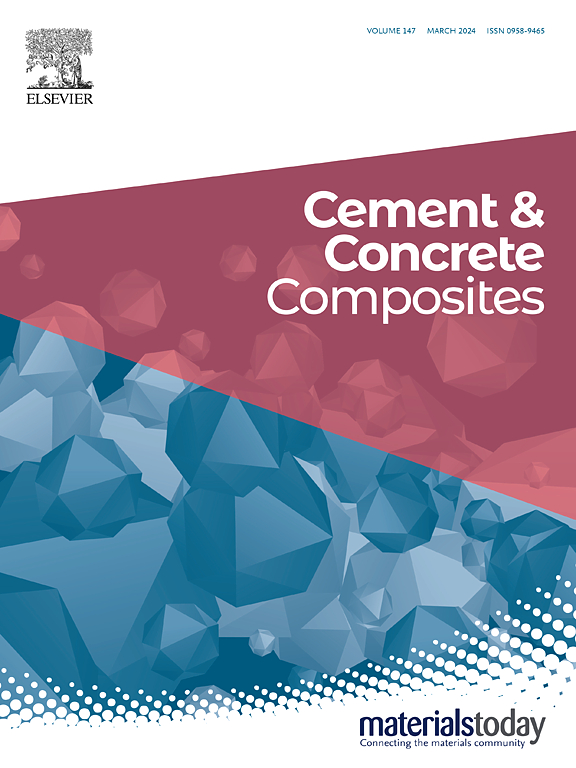基于农业生物炭的水泥砂浆的性能、微观结构和碳封存潜力
IF 10.8
1区 工程技术
Q1 CONSTRUCTION & BUILDING TECHNOLOGY
引用次数: 0
摘要
本研究旨在评估生物炭的利用和早期二氧化碳固化对水泥基材料的机械性能、水化和二氧化碳吸收的协同作用。研究使用了三种不同的生物炭:竹生物炭(BBC)、花生壳生物炭(PHBC)和稻壳生物炭(RHBC),其用量最高可达水泥质量的 5%,并研究了它们在水固化和早期二氧化碳固化条件下的影响。利用傅立叶变换红外光谱(FTIR)、X 射线衍射仪(XRD)、热重分析仪(TGA)、扫描电镜-电子显微镜(SEM-EDS)对最佳生物炭混合物进行了分析研究,以确定各种生物炭混合物的微观结构、水化、碳化和二氧化碳吸收特性。结果发现,BBC & PHBC 的最佳用量为 1%,而从强度角度来看,RHBC 的最佳用量为 2%。除其他水化产物外,碳酸钙多晶体--无定形 CaCO3 和文石是主要产物。生物沥青多孔的表面使水合产物沉淀的能力得到了揭示。与不含生物炭的对照组相比,以 2% 稻壳生物炭为基础的早龄期二氧化碳固化混合料的水化程度提高了 23%,二氧化碳吸收率提高了 19%。在烟道气二氧化碳浓度为 17% 的环境条件下,48 小时二氧化碳固化可提高早期龄期强度,这对于在生产碳沉胶凝产品的工业装置中采用这种方法大有可为。本文章由计算机程序翻译,如有差异,请以英文原文为准。
Performance, microstructure and carbon sequestration potential of agro biochar based cement mortars
This study is aimed at assessing the synergy of the biochar utilization and early age CO2 curing on the mechanical performance, hydration and CO2 uptake in cementitious materials. Three different biochars Bamboo biochar (BBC), Peanut Husk Biochar (PHBC) and Rice Husk Biochar (RHBC) were utilized with dosages up to 5 % by mass of cement and their influence under water curing and early age CO2 curing was studied. Analytical studies using FTIR, XRD, TGA, SEM-EDS were extended on optimum biochar mixes for characterizing the microstructure, hydration, carbonation and CO2 uptake of various biochar based mixes. The optimum dosage was found to be 1 % for BBC & PHBC while it is 2 % in RHBC from a strength perspective. Calcium carbonate polymorphs – amorphous CaCO3 and aragonite are found to be dominant products besides other hydration products. The biochars porous surface ability to enable hydration products precipitation is revealed. Early age CO2 curing resulted in 23 % improved degree of hydration and 19 % improved CO2 uptake with 2 % rice husk biochar based mix compared to control mix without biochar. The improved early age strength with 48 h CO2 curing at flue gas CO2 concentration of 17 % and under ambient conditions were found to be promising aspects for implementation of this method in an industrial set up for production of carbon sinking cementitious products.
求助全文
通过发布文献求助,成功后即可免费获取论文全文。
去求助
来源期刊

Cement & concrete composites
工程技术-材料科学:复合
CiteScore
18.70
自引率
11.40%
发文量
459
审稿时长
65 days
期刊介绍:
Cement & concrete composites focuses on advancements in cement-concrete composite technology and the production, use, and performance of cement-based construction materials. It covers a wide range of materials, including fiber-reinforced composites, polymer composites, ferrocement, and those incorporating special aggregates or waste materials. Major themes include microstructure, material properties, testing, durability, mechanics, modeling, design, fabrication, and practical applications. The journal welcomes papers on structural behavior, field studies, repair and maintenance, serviceability, and sustainability. It aims to enhance understanding, provide a platform for unconventional materials, promote low-cost energy-saving materials, and bridge the gap between materials science, engineering, and construction. Special issues on emerging topics are also published to encourage collaboration between materials scientists, engineers, designers, and fabricators.
 求助内容:
求助内容: 应助结果提醒方式:
应助结果提醒方式:


